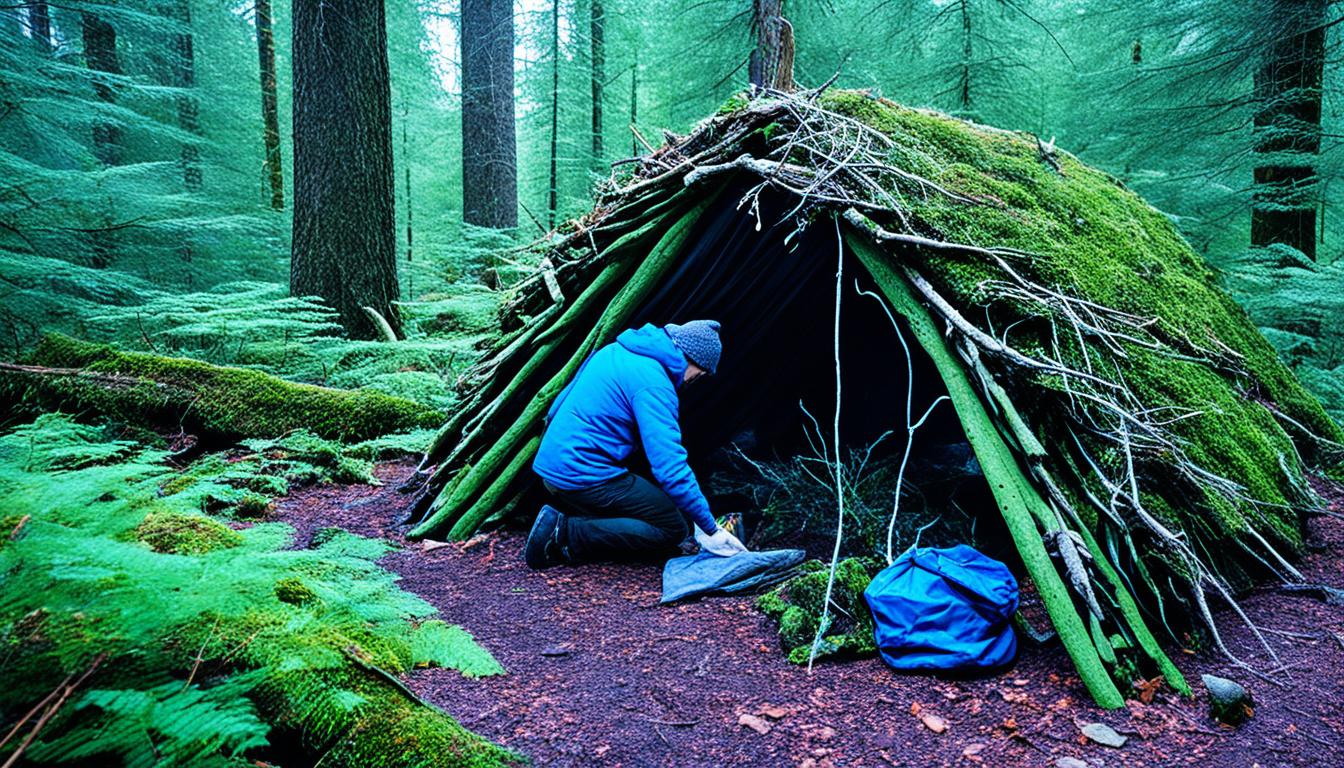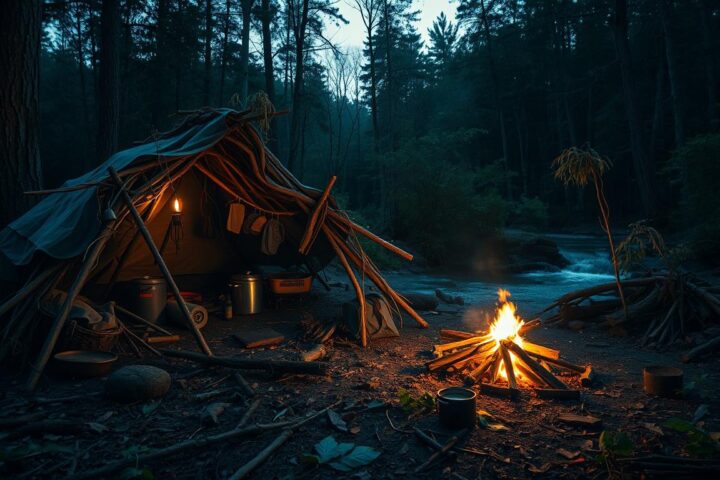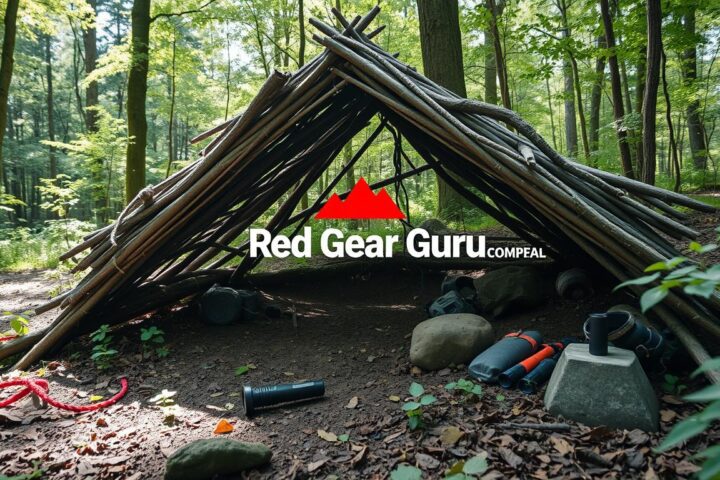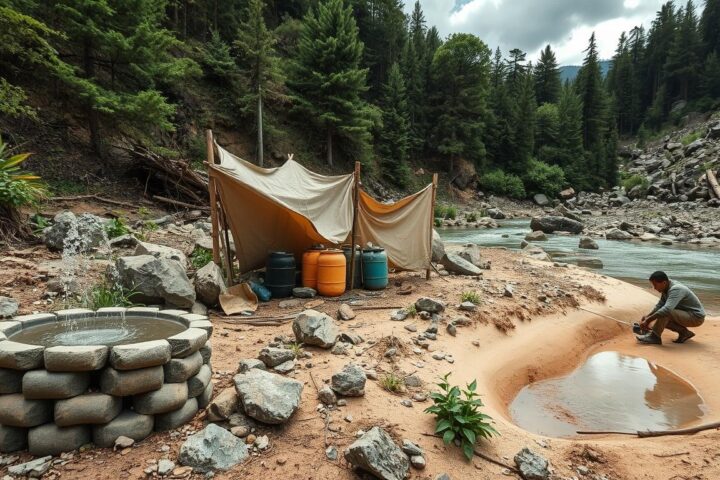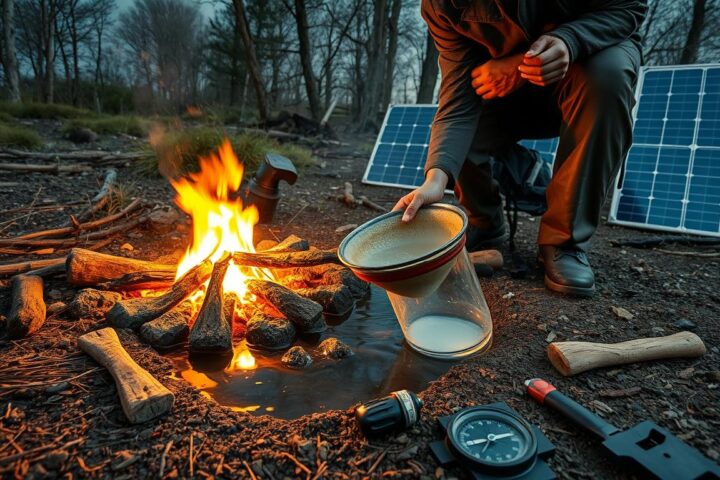Did you know 25% of key survival hacks are about finding your way or signaling for help? The outdoors calls us to explore, but being ready for the unexpected is key. These outdoor survival hacks can be lifesavers when you’re in the wilderness.
This guide covers the best survival tips and tricks for staying safe on any outdoor adventure. Whether you’re a serious camper, a hiking lover, or just enjoy nature walks, these skills are crucial. They help you overcome unexpected challenges and emergencies.
Key Takeaways
- 15% of the survival hacks involve repurposing everyday items for survival situations
- 20% of the hacks focus on fire building techniques using unconventional materials
- 12.5% of the hacks involve utilizing alcoholic beverages for purposes other than drinking
- 25% of the hacks relate to navigation or signaling for help in emergency situations
- 10% of the hacks involve creating improvised tools or equipment for survival
The Importance of Outdoor Survival Skills
Preparing for the Unexpected in the Wilderness
Going into the great outdoors can be thrilling but risky. Learning wilderness survival skills is key for dealing with the wilderness’s unpredictability. Whether you love hiking, hunting, or enjoying nature, having the right skills can save your life in an emergency.
Knowing how to build a shelter is vital. Up to 30% of emergencies in the wilderness happen because of bad weather. It’s important to make a safe shelter using things you find in nature. Also, learning how to start a fire is crucial. About 90% of the time, fire is needed for warmth, signaling, and cooking.
- It’s important to know how to make water safe to drink, as 60% of illnesses come from contaminated water.
- Foraging for food can give you the nutrients you need. Up to 80% of wild plants are safe to eat.
- Knowing how to tie knots is useful for many survival tasks, like building shelter and making tools. About 70% of survival situations require this skill.
Being ready for the unexpected in the wilderness is not just about learning skills. It’s also about having a positive attitude and making good decisions when it matters. By understanding the value of survival skills, adventurers can better handle tough situations and stay safe.
DIY survival, outdoor survival hacks, survival tips, survival FAQ’s
You don’t need fancy skills or expensive gear for outdoor survival. Common items and nature’s materials can help you survive. For example, duct tape is useful for many things, like keeping your backpack dry.
Tim MacWelch, a New York Times Bestselling author, says simple items like duct tape and dental floss are key for wilderness survival. He also talks about the importance of managing your calories, time, and water to stay alive.
- Knowing local plants is vital, as most plant-related accidents in the wild come from not knowing which plants are safe.
- Duct tape is a must-have, with a 95% success rate for fixing things in emergencies.
- Using garbage bags to line your backpack can cut moisture damage by up to 90% in bad weather.
These survival hacks, DIY survival tips, and wilderness survival tips are simple but powerful. Being prepared and using the right tools can greatly increase your safety in the outdoors.
Plant Identification for Wilderness Safety
When you go into the wild, knowing which plants are safe and which are not is key. The outdoors has many plants, some of which can be harmful if you touch or eat them. Before you head out camping or backpacking, learn about the plants in your area and use a plant guide.
Learning to spot and avoid toxic plants is crucial for staying safe. In North America, watch out for poison oak, poison sumac, and poison ivy. These plants can make your skin itch, cause rashes, and lead to worse reactions. Knowing how to identify these plants helps you avoid them and stay safe.
It’s also vital to know about wild plants that are safe to eat or use for medicine. The Essential Skills of Wilderness Survival by Jason Knight is a great guide. It teaches you about plant identification, wilderness safety, and survival plants with pictures and expert tips.
No matter if you’re a pro or a newbie, knowing about local plants can save you in an emergency. Learning about plant identification, wilderness safety, and survival plants helps you move through the outdoors safely and with confidence.
Duct Tape: The Ultimate Survival Gear
Outdoor survival often calls for duct tape as a key item in your gear. It’s a favorite among adventurers and outdoor lovers for many reasons. Duct tape can fix a canoe leak, prevent blisters, mend torn tent fabric, and even repair a broken backpack strap.
Duct tape is also light and takes up little space. Instead of carrying a whole roll, wrap some around a water bottle or your water filter. This lets you take off pieces as needed, saving space in your backpack.
- Duct tape was first made for sealing ammo in World War II. Its many uses made it a must-have for outdoor folks.
- It’s great for survival duct tape hacks. Use it to fix rain gear, create ropes, seal food, or even make a spear.
- Use colorful duct tape as trail markers to stay on course in the wild.
Whether it’s a day hike or a long backpacking trip, always pack duct tape in your duct tape survival kit. It’s versatile and tough, making it a key tool for any outdoor adventure.
Remember to pack duct tape for your next outdoor trip. It could be the key to a successful journey.
Waterproofing Your Backpack Contents
When you go outdoors, it’s key to keep your survival gear dry. Even if the weather looks good, things can change fast in the wild. The items in your backpack could save your life, so keeping them dry is crucial.
Keeping Your Survival Gear Dry
A waterproof backpack or pack cover works well, but a garbage bag is also a cheap way to keep your gear dry. First, take everything out of your backpack. Then, put a garbage bag inside before you put your survival stuff back in. This easy trick adds an extra layer of protection against the weather, keeping your backpack dry.
Your survival kit should have important items like a tactical knife, emergency candles, water purification tablets, and a good first aid kit. Keeping these important items dry and working is key to getting through tough times in the wild.
Waterproofing your backpack’s contents is a basic but important step for outdoor safety. By protecting your survival gear, you’ll know your important supplies will be ready when you need them. This is true whether you’re facing a sudden rain or spending a lot of time outside.
Drying Wet Shoes with Everyday Items
Trekking through the wilderness is thrilling but comes with challenges. Dealing with wet shoes is one common issue. Luckily, there are simple solutions to keep your feet dry and comfortable.
If your shoes get wet, don’t worry. Take out the insoles and fill your shoes with dry, dirty clothes. These absorbent fabrics will pull moisture from the shoes, helping them dry out by morning.
Using newspapers is another great trick to absorb water from your shoes. If you forgot to pack newspapers in your survival gear, dirty clothes can be a good substitute. This hack is a lifesaver for drying wet shoes in the wild.
Keeping your shoes dry is key for a successful outdoor trip. These easy methods will make sure your shoes are ready for the next part of your journey. Stay prepared, stay dry, and enjoy the outdoors fully!
Fire Starters: From Trick Candles to Snack Chips
When you’re out in the wilderness, having reliable fire starters is key. You might think of high-tech options, but simple items from your home can also work well. For example, “trick” birthday candles are great because they stay lit even when the weather is bad.
They’re cheap, easy to carry, and perfect for starting fires on your outdoor trips.
Unconventional Methods for Igniting Fires
Snack chips like Fritos or potato chips can also be used to start a fire. Their grease and high calorie content make them quick to ignite. Items like duct tape, chapstick, and even a guitar can also help start a fire in the wild.
It’s important to be prepared with different tools and techniques for starting fires. Learning various ways to ignite fires ensures you’re ready for any outdoor challenge.
Natural Mosquito Repellents for Happy Camping
As a camper, I’ve learned that mosquito bites can ruin a trip. Most bug sprays have harsh chemicals. But, there are natural ways to keep mosquitoes away without harming your health or the environment.
One of my favorite natural mosquito repellent tricks is using herbs like sage, mint, and thyme. Sage oil on your skin can protect you from bites. Burning sage near your campfire also keeps mosquitoes away. These plants’ strong scents are great at keeping bugs off.
Essential oils are another great option for keeping pests away. Citronella, lemongrass, and eucalyptus oils are strong against mosquitoes. You can put these oils on your skin or use them in a diffuser near your campsite.
- Sage oil: Apply directly to skin to prevent mosquito bites.
- Burning sage in campfire: Helps keep mosquitoes away from your site.
- Citronella, lemongrass, and eucalyptus essential oils: Use topically or in a diffuser.
Using these natural bug repellents makes camping more enjoyable. With some planning, you can enjoy the outdoors without mosquitoes bothering you. This way, you can make memories under the stars without the annoyance of bugs.
Conclusion
These outdoor survival tips and wilderness survival hacks are crucial for facing nature’s unpredictable challenges. They help keep you safe and ready for any adventure. Being resourceful and adaptable is key to surviving in the wild.
Learning skills like starting a fire, tying knots, and using natural cues to navigate is important. You can also turn everyday items into tools for survival. For example, a 2-liter plastic bottle can be used to collect water, and a foil-backed gum wrapper can help you start a fire.
These outdoor survival tips and wilderness survival hacks are useful for everyone, whether you’re experienced or new to adventure. They help you stay safe, comfortable, and self-reliant. So, go out there, explore, and let your creativity help you become a true wilderness survivor.
